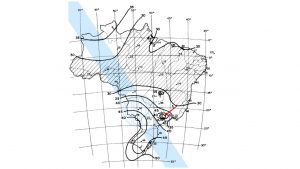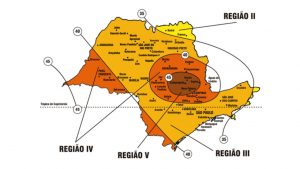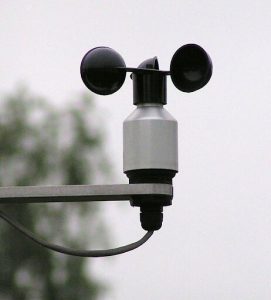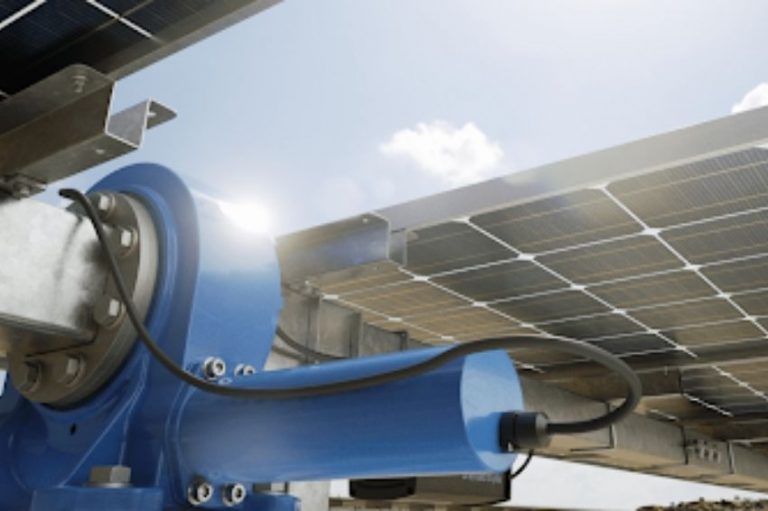One of the biggest issues when sizing structures and solar trackers is the stress they receive from the wind.
As the tracker and modules are susceptible to various angles, various forces from winds can affect them during the day.
It is worth noting that strong winds are not necessarily typhoons, but also dynamic winds of moderate strength.
Aligning communication technology and real-time measurements, solar trackers have a protection system that is activated when the wind reaches a certain safe speed determined by the project or the manufacturer.
When the system is activated, an angular position is defined and the panels are relocated to a safe position where they better receive wind impacts without causing material damage to the structure, trackers and, consequently, modules.
Winds in regions of Brazil
According to the standard NBR 6123 – Forces due to wind in buildings, the basic winds are defined by regions, considering a gust of 3 seconds, occurring on average once every 50 years, 10 meters above the ground, in an open and flat field, and can be in any direction.
The NBR 6123 standard defines the isopleths (lines of equal basic wind speed) for the Brazilian territory. The isopleths define 5 ranges of wind speeds recorded in the territory. On the map below we can see the regions and basic winds defined by the standard.
The isopleths define 5 wind regions in Brazilian territory:
- I – Winds up to 30 m/s
- II – Winds of 30 m/s to 35 m/s
- III – Winds of 35 m/s to 40 m/s
- IV – Winds of 40 m/s to 45 m/s
- V – Winds of 45 m/s to 50 m/s

The figure below illustrates the territory of the State of São Paulo, where we can verify the presence of different wind regions, defined according to the isopleths of the national territory.
The city of Campinas (SP), for example, is located in region IV, from 40 m/s to 45 m/s. In that same city, however, winds of up to 162 km/h have been recorded.

Field wind records
Tracking solar systems necessarily have an anemometric station to measure wind speed. Anemometers can be rotating, equipped with cup-shaped blades, or ultrasonic, which do not have moving parts.

For the trackers to receive the information obtained by the anemometers, there must be communication between them. A control station present at the solar plant must be responsible for collecting the anemometer data and commanding the withdrawal of the trackers in the event of wind speeds above a pre-determined limit.
The control systems are activated according to the risk situation and can be regulated based on the location's history, making the action parameters personalized for each region and type of weather, such as hail and floods.
Dynamic wind effects
Tracker manufacturers do not consider wind as a static load, as the incidences of tracker and module breakages mostly come from dynamic phenomena, according to the Nextracker study “Mitigating Extreme Weather Risk”.
A resonant structure, which is the case of tracker structures, and with dynamic wind loads, can suffer six times more loads than a non-resonant structure, showing that a study with only static loads is not enough to mitigate claim risks.
Security position
For each type of weather, it is necessary to study a different angle for retracting the tracker to the safety position. In the case of hail, for example, the module must be adjusted to a position with a high angular inclination. Floods, however, require a low slope angle.
In the case of winds, the completely retracted position of 0º is not the most suitable as previously thought. Modules retracted to this position are more susceptible to dynamic wind loads. Therefore, experts recommend a safety position of 30º to 60º degrees with the module face in the direction of the wind. For this, it is important that the anemometric station also has a device for determining the wind direction.
Command and control
Commands can be activated manually or automatically by operators when they deem it necessary. Once the retraction mode is activated, the entire plant can reach the indicated position within three minutes. Below we can check the interface of Nextracker's navigation system, NX Navigator.

















2 Responses
“The city of Campinas-SP, for example, is located in region IV, from 40 m/s to 45 m/s. In that same city, however, winds of up to 162 km/h have been recorded.”
162 km/h is equivalent to 45 m/s. If winds of up to 162 km/h were recorded, it is within the range for the region.
Exactly, our intention was to show that the winds recorded in the region can indeed reach the limit indicated in the isopleth.